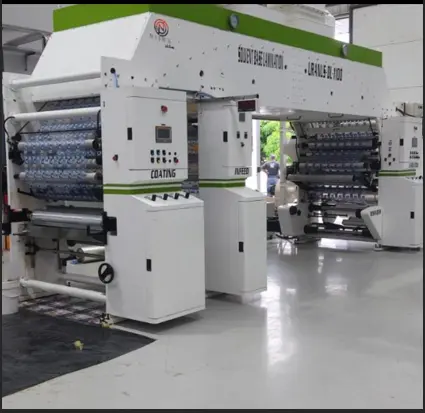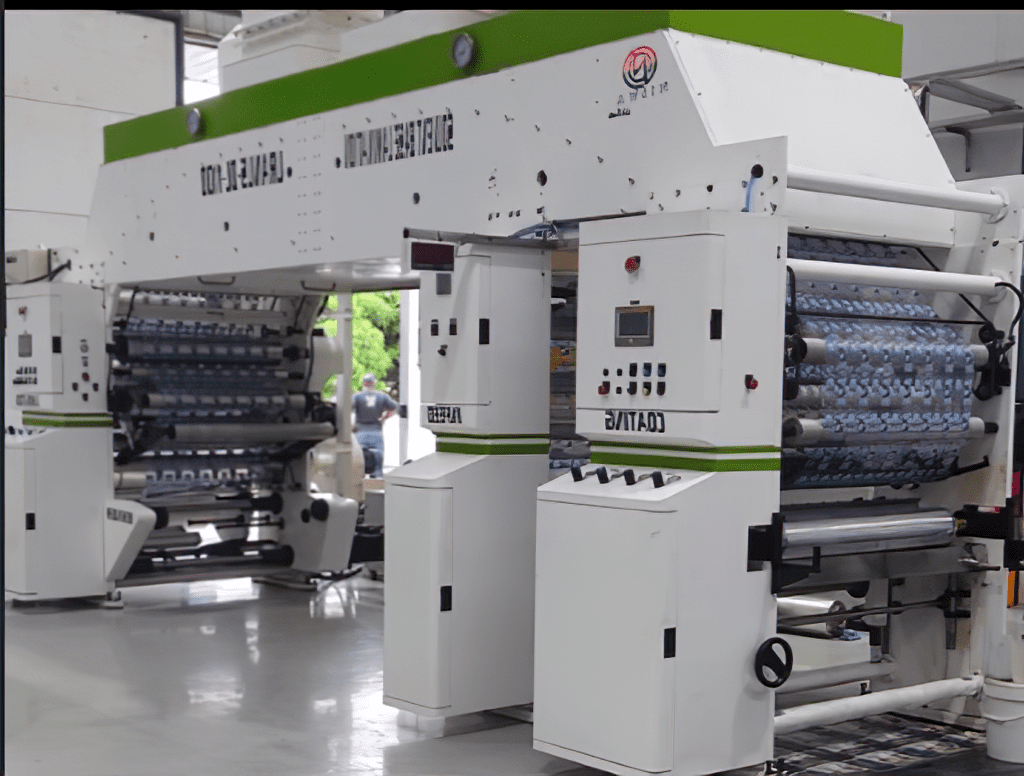Dry Lamination Machine/Solventbase
Niswa Dry Lamination is specially design for roll Lamination operation for flexible packaging material such as BOPP, EPP, PET, Aluminum foil and a variety of multi layer films job. For surface treatment.

Dry Lamination M/c Uranus 300
| Dry Lamination Machine | Unit | Uranus 300 MPM |
| Mechanical Speed | Mtr/min | 300 |
| Maximum Web Width | mm | 1320/1050 |
| Minimum Web Width | mm | 920/650 |
| Maximum Roll Diameter Unwinder | mm | 1000 |
| Inside Core Diameter Unwinder | mm | 76/152 |
| Maximum Diameter Rewinder | mm | 1000 |
| Inside Core Diameter Rewinder | mm | 152 |
Dry Lamination M/c Uranus 250
| Dry Lamination Machine | Unit | Uranus 250 MPM |
| Mechanical Speed | Mtr/min | 250 |
| Maximum Web Width | mm | 1050 |
| Minimum Web Width | mm | 650 |
| Maximum Roll Diameter Unwinder | mm | 1000 |
| Inside Core Diameter Unwinder | mm | 76/152 |
| Maximum Diameter Rewinder | mm | 1000 |
| Inside Core Diameter Rewinder | mm | 152 |


Dry Lamination M/c Uranus 200
| Dry Lamination Machine | Unit | Uranus 200 MPM |
| Mechanical Speed | Mtr/min | 200 |
| Maximum Web Width | mm | 1050 |
| Minimum Web Width | mm | 650 |
| Maximum Roll Diameter Unwinder | mm | 800 |
| Inside Core Diameter Unwinder | mm | 76/152 |
| Maximum Diameter Rewinder | mm | 1000 |
| Inside Core Diameter Rewinder | mm | 152 |
Description
1. Principle of Operation:
- Dry lamination machines utilize heat and pressure to bond layers of materials together. Unlike wet lamination, which uses adhesives that require drying time, dry lamination relies on heat-activated adhesive layers or thermoplastic films to create a strong bond.
2. Materials Used:
- Dry lamination machines can bond various materials such as films, foils, papers, and non-woven fabrics. These materials can be of different thicknesses and compositions, providing flexibility in creating laminated structures tailored to specific product requirements.
3. Key Components::
- Unwinder: This is where the materials to be laminated are fed into the machine. Each material layer is unwound from its respective roll.
- Adhesive Application: Dry lamination machines may include modules for applying heat-activated adhesive or thermoplastic films onto one or both sides of the substrate.
- Laminating Section: The heart of the machine, where the layers are brought together and subjected to controlled heat and pressure to form a bond.
- Heating and Pressure Rollers: These rollers apply heat and pressure evenly across the laminating surfaces, ensuring proper adhesion.
- Rewinder: Once the lamination process is complete, the laminated material is wound onto a roll for further processing or packaging.
4. Control Systems:
- Modern dry lamination machines feature advanced control systems that regulate parameters such as temperature, pressure, speed, and tension to ensure consistent lamination quality and minimize waste.
5. Applications:
- Dry lamination machines are used in various industries for packaging applications such as flexible packaging for food, pharmaceuticals, and consumer goods. They are also used in printing for producing laminated labels, pouches, and other printed materials with enhanced durability and aesthetics.
5. Advantages:
- Environmentally friendly: Since dry lamination does not use solvents, it eliminates the need for solvent recovery systems and reduces emissions.
- Faster production: Dry lamination processes typically have shorter setup and curing times compared to wet lamination, leading to higher productivity.
- Superior quality: Dry lamination can achieve high bond strength and excellent clarity, making it suitable for applications requiring premium appearance and performance.
Materials Handled
Films: Various types of plastic films such as polyester (PET), polyethylene (PE), polypropylene (PP), nylon (PA), and polystyrene (PS) can be laminated using dry lamination. These films may have different thicknesses and properties depending on the desired application.
Foils: Thin metallic foils such as aluminum foil are commonly laminated onto substrates for barrier properties, heat resistance, or decorative purposes.
Papers: Different grades of paper, including coated and uncoated papers, paperboard, and specialty papers, can be laminated to enhance their strength, durability, and barrier properties.
Non-Woven Fabrics: Non-woven materials made from synthetic fibers or natural fibers can be laminated to provide additional strength, stiffness, or barrier properties.
Flexible Packaging Substrates: Dry lamination machines can laminate multiple layers of films, papers, and foils together to create flexible packaging structures suitable for food packaging, pharmaceuticals, cosmetics, and other consumer goods.
Labels and Decals: Dry lamination is also used in the printing industry to laminate printed labels, decals, and stickers for added durability and protection against abrasion, moisture, and chemicals.
Barrier Films: Specialized barrier films such as metallized films, vapor barrier films, and oxygen barrier films can be laminated onto substrates to provide specific barrier properties for food packaging and other applications.
Adhesive Layers: Dry lamination machines can apply heat-activated adhesives or thermoplastic films onto substrates to facilitate bonding between different layers.
